Tom's Hardware Verdict
The Keychron K8 Pro doesn’t feel like a substantial upgrade to the regular K8, with terrible keycaps, poor Bluetooth performance, and a lackluster tray-mount style that makes some of the upgrades here, like sound-dampening foam, moot.
Pros
- +
+ Long battery life
- +
+ QMK/VIA support
- +
+ Affordable
- +
+ Durable Body
- +
+ Hot-swappable
Cons
- -
Terrible keycaps
- -
Bluetooth performance issues
- -
No per-key RGB in software
- -
Tray-mount
Why you can trust Tom's Hardware
There are many things to consider when trying to make the best mechanical keyboard, especially when it’s wireless. On top of mounting styles, switches, keycaps and sound, you also need to ensure strong connectivity. In late 2021, Keychron’s Q-series of gasket-mount mechanical keyboards nailed its physical build thanks to a high level of customization, a satisfying gasket-mount enabled typing experience and affordable price.
Now, the Keychron K8 Pro aims to take some of the enthusiast features from those boards, including hot swappable switches, and bring them to the wireless and generally cheaper Keychron K line. The result, unfortunately, is a board that suffers from poor quality control and has more cut corners than even a mid-budget ($79 for a barebones model and $109 to get it fully-assembled) “Pro” model should.
Keychron K8 Pro Specs
| Switches | Gateron G Pro Brown |
| Lighting | Non-addressable |
| Onboard Storage | 4 Profiles |
| Media Keys | With FN |
| Connectivity | USB Type-C |
| Cable | 4 feet, braided |
| Additional Ports | None |
| Keycaps | Doubleshot PBT |
| Software | QMK, VIA |
| Dimensions (LxWxH) | Include inches (355.6 x 127x 35mm) |
| Weight | 2.5 pounds |
Design for the Keychron K8 Pro
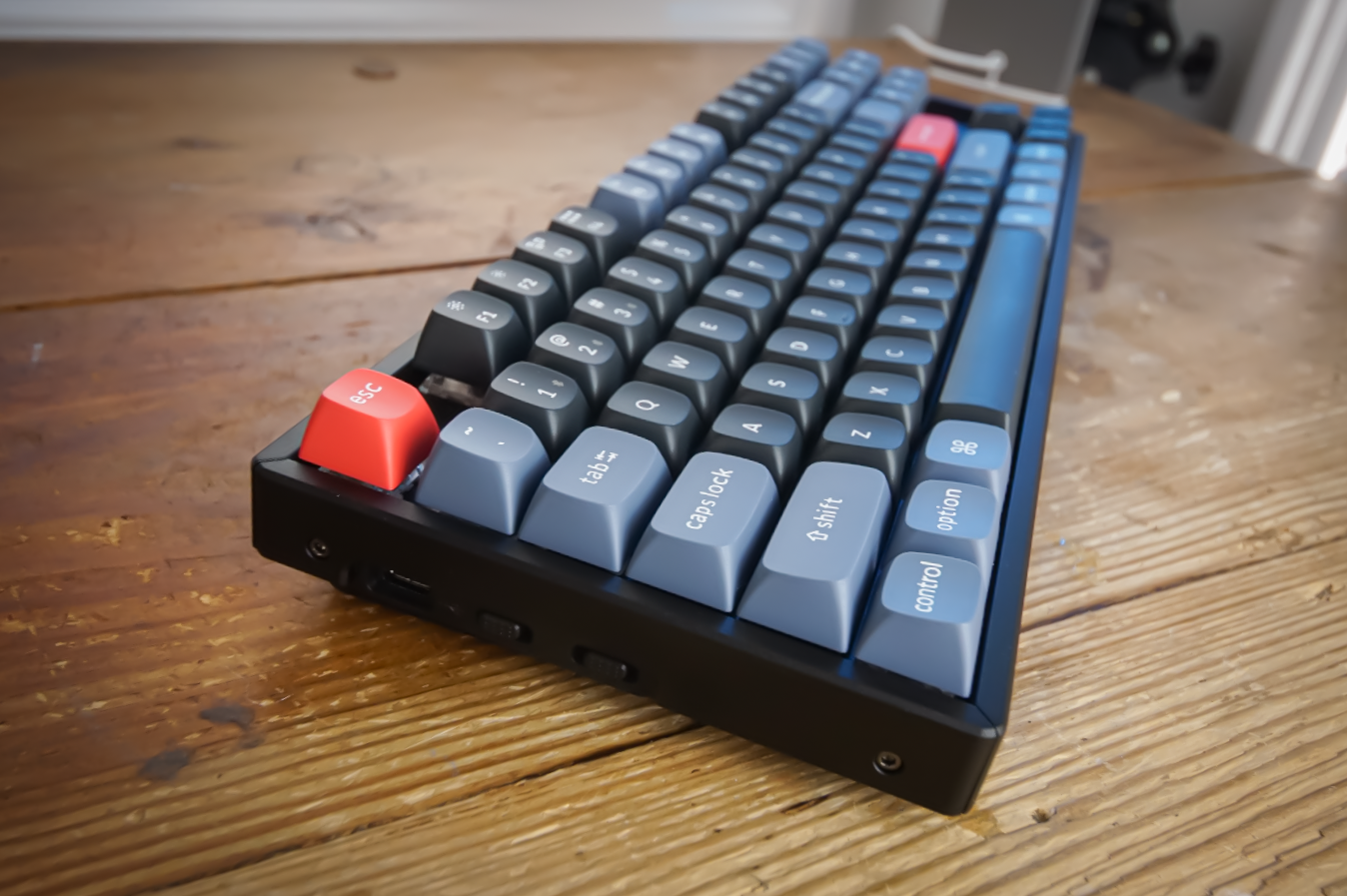
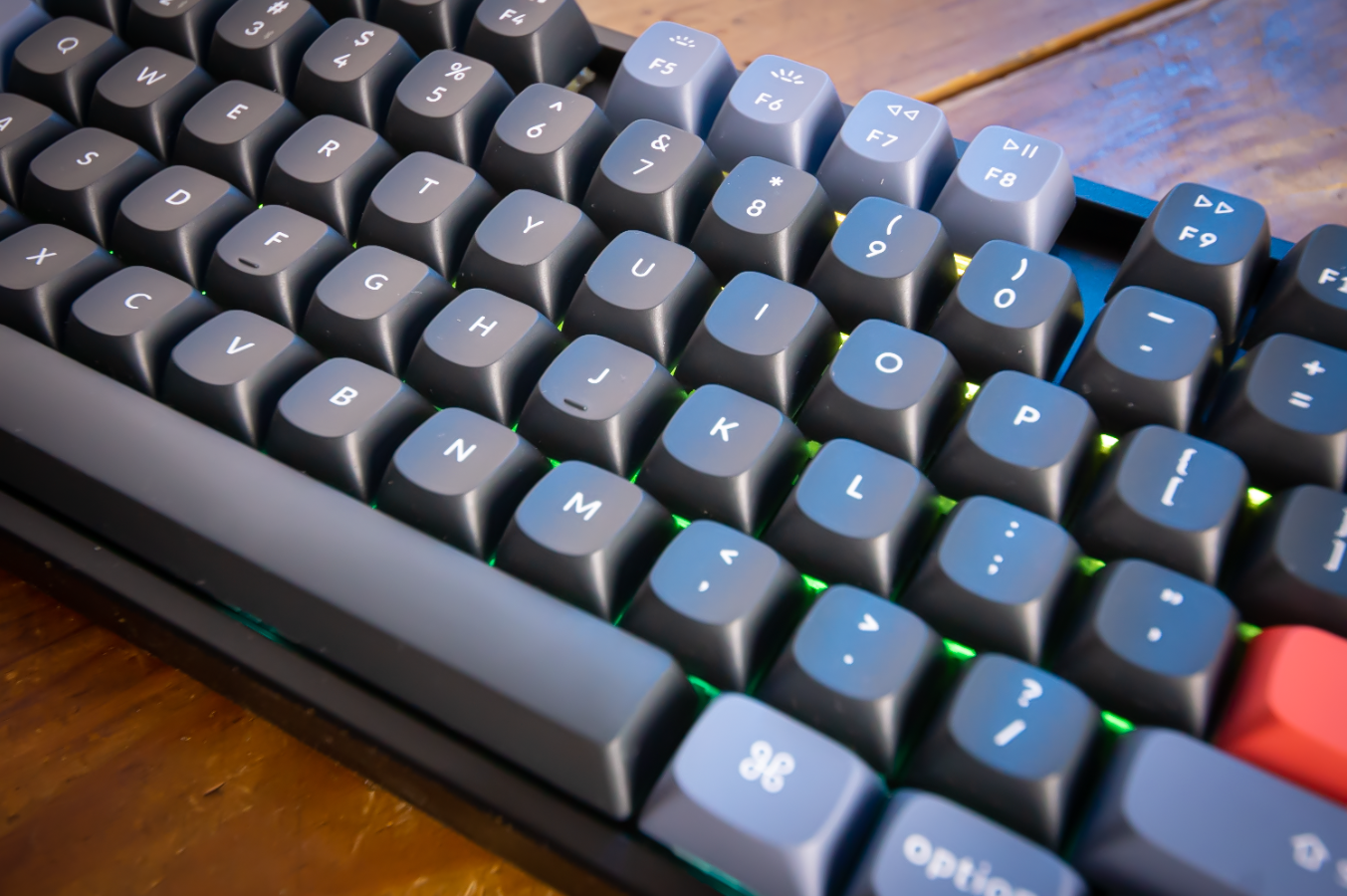
The K8 Pro is a step-up for the K line in that it incorporates some of the features found in Keychron’s Q lineup, like screw-in stabilizers, hot-swap sockets and sound dampening materials. Like the regular K8, the K8 Pro uses a TKL (tenkeyless) layout and a more traditional tray-mount style design.
While a TKL layout is fine, a tray-mount style is the polar opposite of the gasket-mount style that worked so well in the Q line.Tray-mount boards differ from gasket mounts by utilizing screws that penetrate through all of the board’s layers, whereas gasket-mounts rely on fewer screws or none, depending on the model. Tray-mounts are often criticized by the mechanical keyboard community because they are frequently stiff and sound can be inconsistent across the board. The Keychron K8 Pro is no exception here.
If this were the normal K8 rather than the Pro version, I would have been fine with this board being tray-mount. Here, though, I’d rather see something like a top-mount style, which would allow for more switch plate options and a less stiff typing experience. I understand that the K line is meant to be cheaper than the Q line, but as a pro model and also one of the few wireless models with extras like sound-dampening foam, the K8 Pro could do with just a little extra care.
The K8 Pro’s keycaps are the same OSA ones that come with the Keychron Q2, and even though this is a newer board, they still look atrocious. The included keycaps are double-shot PBT, which means that they are injected with a second type of plastic, which provides more durability over standard dye-sub keycaps. One of the selling points for double-shot keycaps, whether they are ABS or PBT, is that they tend to provide higher quality legends, but this isn’t the case for Keychron’s OSA keycaps.
Compared to other PBT keycaps I’ve used from other companies, these ones from Keychron felt slick like brand new ABS caps, which is unusual for PBT. PBT caps tend to grip better than ABS keycaps due to their coarse texture, but these didn’t do that at all.
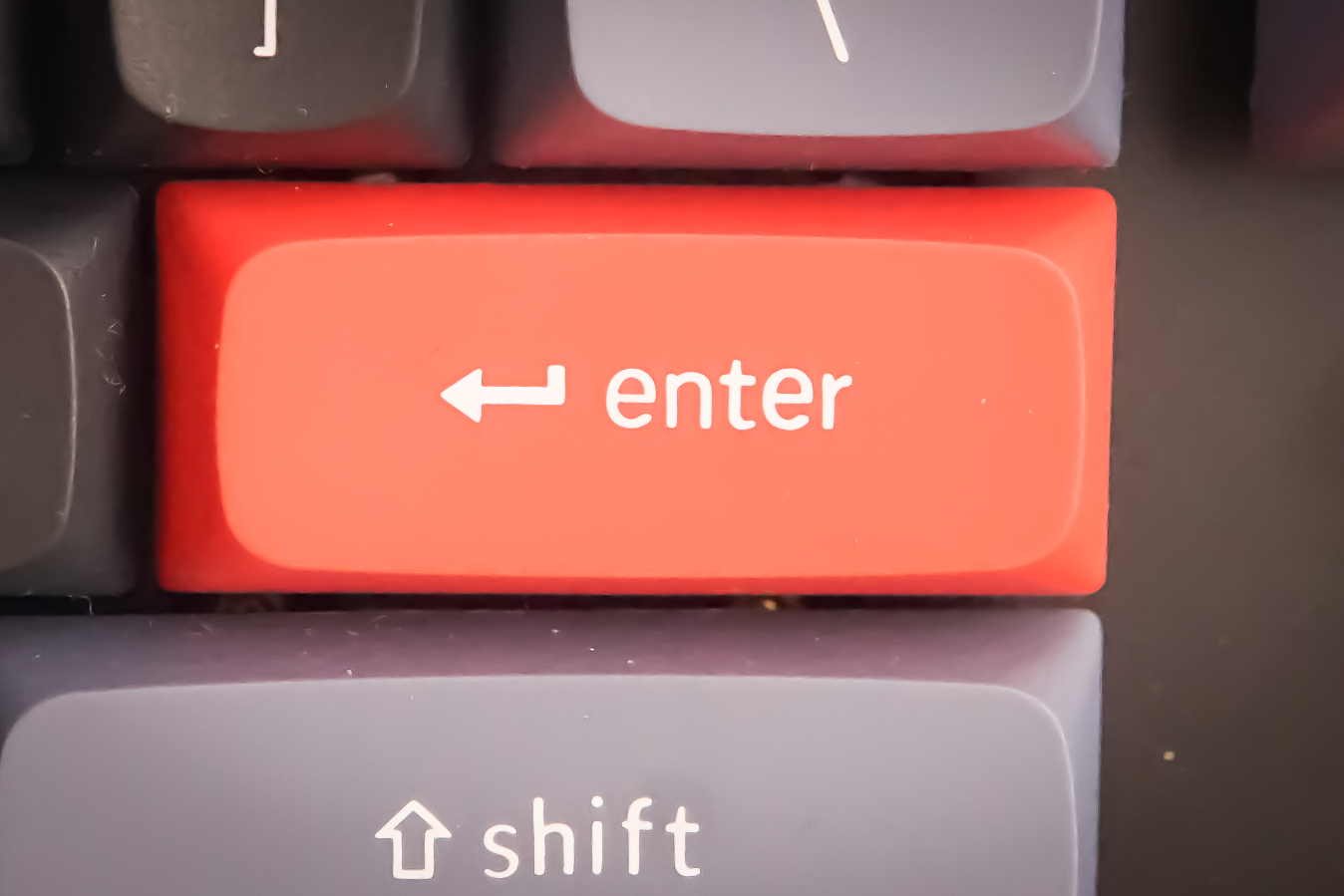
On top of the caps feeling weird, they also look weird if you look at the printing. For me, the backspace key looks like it says “backs pace” and the page-up one looks like it says “pgu p.” There’s font issues like this all over the keyboard, largely due to different letters having different sizes, although they’ll probably bother different people in different ways.
The media control keys are also set to F7-F9, which makes the layout look awkward. The next track key isn’t on the same cluster as the previous and pause track keys because of this, which looks weird and might make pressing it without looking difficult.
The K8 Pro starts with a plastic frame, but you can opt for an aluminum one for $10 extra. My review sample came with the aluminum frame, but I worry this might have interfered with the Bluetooth performance. The K8 Pro can connect to up to three devices at once via Bluetooth, but I had consistent connectivity problems that I’ll talk about more in the typing performance section. Keychron did tell me that because my unit is a prototype, it might have issues that consumer models won’t. However, even after flashing a firmware fix the company sent me, my issues persisted. I'm currently arranging to have a replacement sent my way, and will update this review with my experiences testing it.
The battery on the K8 Pro is respectably sized. You get 4000 mAh, which according to Keychron will last up to 100 hours with the RGB set to its lowest brightness. I used the K8 Pro for around 30 hours with the RGB on its brightest setting and it didn’t die on me, so I have no reason to doubt Keychron’s claims.
Inside the K8 Pro are two layers of sound dampening material: silicone and foam. The foam sits between the plate and PCB while the silicone pad is under the PCB. With all of the dampening material, you would think this board’s noise would be more muffled, but this is still a high pitched board. I know some people like high pitched boards, but be aware that the foam doesn’t change the sound profile too much from other K series boards.
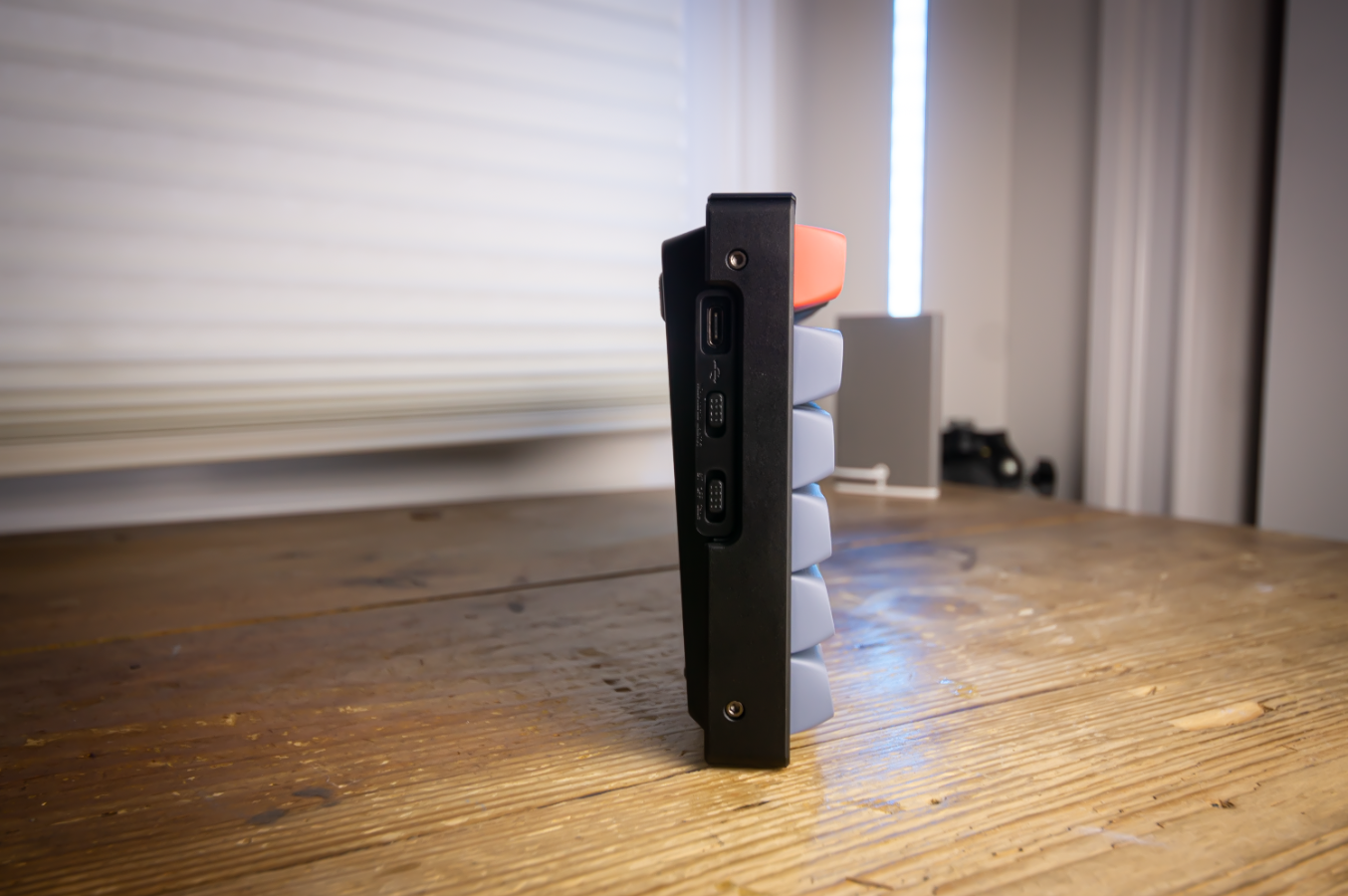
Gateron G Pro Brown switches come pre-installed on this board, and they are nothing special aside from one feature that I will discuss later on. They do allow light to shine through due to the clear upper housings, which is perfect for this board’s south-facing RGB.
One of the biggest upgrades on the K8 Pro versus its standard K8 sibling is the stabilizers. The included stabilizers are PCB screw-in, which rattle much less than the usual plate-mount ones. However, my stabilizers arrived bone dry, so I recommend you check out our tuning guide for tips on how to lube them.
I relied on Bluetooth mode with the K8 because the way the USB Type-C connects to this board is weird– it’s on the left side. The included cable is angled, but it’s oddly short. Most included cables are six feet in length, but this thing is only four feet.
Also on the keyboard’s left side are two switches: One that toggles between Mac or Windows and another that enables Bluetooth.
Typing Experience on the Keychron K8 Pro
As mentioned earlier, the K8 Pro uses a more traditional tray-mount design, making the sound profile less uniform and the typing experience stiff thanks to the heavy use of screws. Keychron did a fantastic job creating a mostly screwless gasket-mount board with the Q1 and it only got better with the Q2, so given this board’s Pro classification, something other than a tray-mount style would’ve been appreciated here.
For instance, Keychron’s gasket-mount boards provide an extremely satisfying bounce on keypresses. I would have loved to see a similar experience here. The sound profile is also clacky, despite the inclusion of foam and silicone pads, thanks to the unlubed switches and tray-mount style.
The switches that came with my board are Gateron G Pro Browns (although you can opt for linear Reds or clicky Blues instead), and the only difference I noticed between them and normal MX Brown clones was a reduction in stem wobble. Stem wobble refers to a tolerance issue between the stem and switch housing, and having less wobble is a good thing. Wobble isn’t a dealbreaker for me and can be fixed via filming the switches, which tightens up the switch housing and is a very affordable mod to do. Still, it’s good to know that you won’t have to go through the trouble here.
Aside from a lack of stem wobble, there isn’t much else that stands out with these switches– they still have the same 55g spring weight that you can find on other Browns. In general, you can expect the same experience you’d get from most other Brown switches, which means you’ll have a good mix between speed and feedback thanks to the tactile bump at the top of each switch.
If that experience doesn’t sound ideal to you, this board does let you swap in new switches without soldering, since it’s hot-swappable. Removing the switches took some muscle, though, because the hot-swap sockets are very tight. This is a good thing, because it ensures better stability for 3-pin switches. Just be prepared to apply a bit of force if you decide to change the switches.
Bluetooth connectivity was a major issue with this board, though. When I used this board in Bluetooth mode, the backspace key would keep deleting after I took my finger off of it. Originally, I thought this could have been due to a defective switch, so I replaced it, but that didn’t fix it. Besides that, the Bluetooth works fine, but if you hold the backspace key down when typing, don’t use this board in Bluetooth mode. I have to assume that includes a lot of you, so I reached out to Keychron for comment. The company provided me with a firmware update, but flashing it didn’t fix my problem. I'm currently arranging to get a replacement unit, and will update this review once I test it.
Gaming Experience on the Keychron K8 Pro
I’ve been playing a lot of Elden Ring of late, and with the announcement of the release date for Obi-Wan Kenobi, I wanted to jump back on to Star Wars Jedi: Fallen Order. This is a tough game– it follows that same Souls-esque recipe where you need to parry, bob and weave quickly. The 55g springs in the Brown switches weren’t too heavy, nor too light for my needs here. The tightened housing around the switch stems also made keystrokes feel more aggressive, which seemed appropriate.
The K8 Pro isn’t designed to be a gaming keyboard, so at stock, this isn’t going to show up at many eSports tournaments. Still, it can moonlight well in gaming so long as you don’t need features like an 8,000 Hz polling rate and don’t plan to connect via Bluetooth, which could increase lag.
The ability to swap switches out here also means you can easily opt for a faster, red switch if the Browns aren’t quite twitchy enough for you.
Software for the Keychron K8 Pro
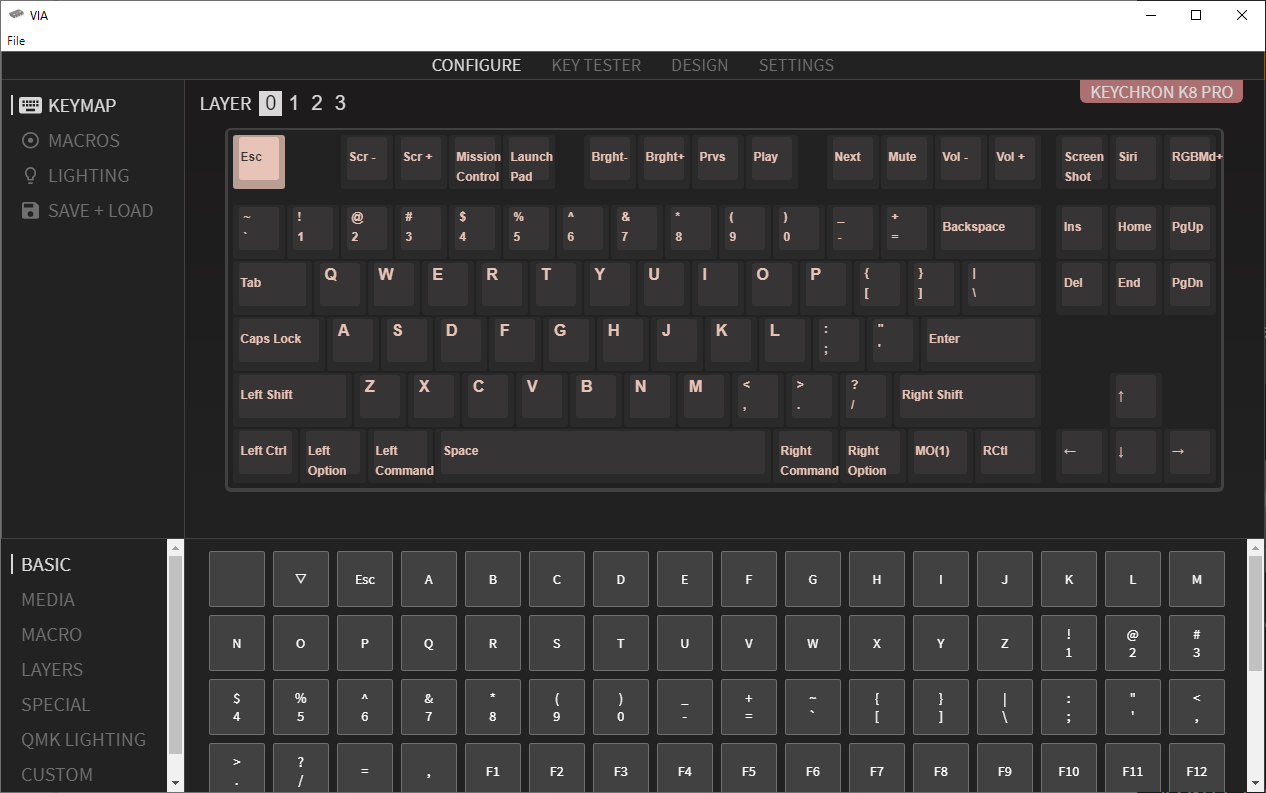
Since Keychron introduced QMK and VIA support for the Q-series, I was curious if it would do the same for its other boards. Lieu and behold, it did. QMK is a beloved keyboard customization app because it's open source, allowing for endless possibilities, but I opted for VIA instead due to its ease-of-use.
QMK is a bit dated and requires some coding, but VIA, its sister software, is like any other keyboard remapping software due to its simple UI.
Since the K8 Pro is Bluetooth compatible, I was curious if I could load it into VIA wirelessly like on the Asus ROG Falchion NX. However, this didn’t work. I’m not really bothered by this because I’ve only seen Asus do it, but it would’ve been cool to see.
Since this is a TKL, you get a lot of keys to play with here, so I remapped the keys dedicated to Cortana (Siri on Mac) and Print Screen to copy and paste. I mean, who actually uses Cortana?
That’s not even scratching the surface of the features that VIA offers you, but one that I always use, especially when testing new switches, is the key tester tab. This highlights which key you pressed after you make a keystroke.
Like all of the boards that use VIA or QMK, you don’t get per-key RGB on this board. Instead, you’re given the option to change the hue, saturation and brightness, but I think that’s enough adjustment to fit your needs.
Bottom Line
Keychron has been on a roll since the release of the Q1, but what we have with the K8 Pro is a slight step backwards. The Bluetooth performance is surprisingly bad, the keycaps should immediately be thrown in the garbage and the awkward USB Type-C connector clashes with the otherwise stylish look of this board.
This board can become great in the right modding hands, so I’d go with its barebones version for $79. If you’re a brand loyalist looking for a hot-swap TKL, then I would take a look at the Keychron C1 as it is extremely affordable and leaves room for new switches, keycaps, etc. Another option, especially if you’re looking to fall down the rabbit hole of mechanical keyboards, is the Novel Keys NK87, which we have an extensive review on.

Myles Goldman is a freelance writer for Tom's Hardware US. He reviews keyboards and cases.
-
BillyBuerger ReplyCompared to other PBT keycaps I’ve used from other companies, these ones from Keychron felt slick like brand new ABS caps, which is unusual for PBT
While PBT keycaps are usually made with a texture, that isn't a requirement for PBT. I'm typing right now on some oMo Blank PBT Alps Keycaps which are smooth and not textured. Great keycaps and one of the few modern options for Alps/Matias switches. -
fleurdelis ReplyWhile PBT keycaps are usually made with a texture, that isn't a requirement for PBT.
I suspect that the surface finish is the same as Keychron's ABS keycaps.
I have 3 of their keyboards but the stock keycaps are (IMO) awful. The surface texture is unique: it's not rough but is in an uncanny valley with a very very fine surface texture that's almost but not quite smooth. Swapping them out for even the cheapest OEM caps is preferable as the keyboards themselves are otherwise great. -
Sleepy_Hollowed Well that's certainly a choice for a "Pro" keyboard.Reply
I can understand the bluetooth issues, it's hard to implement well, especially in peripherals, but if that's the case.... man just make it wired and save yourself and us the cost.
I'm pretty certain that it's because for high speed or "reliable" low power transmission, it uses 2.4G frequencies which are so saturated I just use cables for everything really, at least that way I only have to worry about EMI. -
Fiv3Score I feel the review is a little harsh. It's a great starter board for the price. I've been using the K4v2 for some time, and I've had no issues with the Bluetooth function at all. So probably more of a QC issue, or just a bad unit. The OSA profile PBT keycaps are great to me. A lot of people like how they look and feel. I even bought two sets (black/grey) to replace the stock ABS ones on my K4. They don't have a well-defined texture, but it's definitely not smooth or garbage.Reply
I do agree with the USB C placement on the left side. It's one of the things I hate about my K4, as you will need to find a 90 degree adaptor if you want to use aviator style cables or other aftermarket options. The other thing that I don't really like, is how the aluminum frame makes the board look recessed, although I expected this from having the K4. -
warpdriver I think this review was too harsh too.Reply
Connectivity issues aside (could be prototype board issue), I think this is a good keyboard choice in this price range.
I own a Keychron K8 and the Q1V2. The Q1 is their most premium build, and there is now a Q1 Pro which is wireless. I expect they will be adding "Pro" versions to the other models in the Q line. So it didn't really make sense to say the K8 Pro lacks gasket mounting because the Q series is their "upgrade" option if you want gasket mount. The K series is their budget wireless line, and it's been upgraded to be QMK/VIA and with more dampening, new keycaps, all worthy upgrades to justify "Pro". I know that "Pro" is often misused marketing term, but Keychron is not the first maker to do so. I have the regular K8, and definitely I feel it would worthwhile to pay a bit more for this K8 Pro for all the enhancements it offers over the regular model.
Also, you said the G Pro switches were unlubed, which is false. (https://www.keychron.com/products/gateron-switch-set). The switches work fine, maybe a bit pingy, but it's a pretty good sounding keyboard (judging by other sound-test videos I've seen).
Lastly, I feel it's better to pay a few bucks to get the full kit over the barebones. The keycaps are fine IMO and Red switches are a good choice, so why not pay the $20 more? And another $10 gets you the aluminum frame version. Out of the box, I'm pretty sure most people will feel this to be a nice upgrade from their Razer or Logitechs. -
ErikEngerd After putting in switches and new key caps, the tab key had some issues that appeared to have been resolved. However, now after around 6 months this key stopped functioning and I cannot get it to work again. Also, I had quite some issues with the stabilizers to get the sound down and stop rattling. Also the spacebar was never really good.Reply
I might have caused the problem with the tab key myself because of replacing stabilizers, but without the stabilizer issues I would never have opened the keyboard. Also, wakeup of the keyboard was quite slow and sometimes the occasional issue with infinite repeating keys.
I would not recommend this keyboard again. Can definitely recommend the nuphy gem80 and the keydous nj87. These keyboards are a bit heavier but are really solid with good stabizers out of the box.